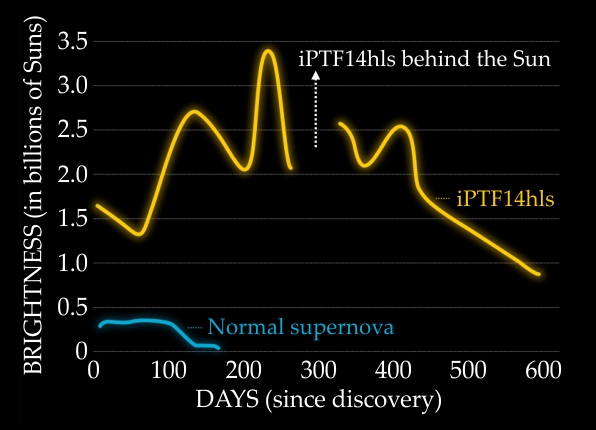A baffling, long-lived supernova
DOI: 10.1063/PT.3.3812
The vast majority of the thousands of supernovae observed so far are easily categorized based on their brightness, duration, and spectrum. At first the supernova iPTF14hls, which was detected in sky survey images from the Intermediate Palomar Transient Factory telescope in September 2014, seemed to check all the boxes for qualifying as a type II-P supernova. In particular, its optical spectrum contained hydrogen absorption lines, suggestive of an expanding shockwave triggered by the collapse of a massive star into a neutron star. But then iPTF14hls did something strange: It kept shining. Type II-P supernovae typically exhibit constant luminosity for about 100 days before fading, as shown in blue on the graph; iPTF14hls glowed for more than 600 days and, as the graph illustrates, peaked in brightness several times. Also unlike the behavior of other type II-P explosions, the velocity and temperature of the light-emitting region remained relatively constant.

ADAPTED FROM LAS CUMBRES OBSERVATORY/S. WILKINSON

The puzzling supernova, about 500 million light-years away in the constellation Ursa Major, was monitored by Las Cumbres Observatory, a global network of telescopes whose longitudinal distribution ensures continuous coverage. Using the observations, Iair Arcavi and colleagues tried to find a model that could explain the prolonged episode. They weighed the possibility that iPTF14hls was the climactic final stage of a pulsational pair-instability supernova, a theorized but never observed event in which an extremely massive star sheds layers in repeated episodes before exploding and collapsing into a black hole (see Physics Today, July 2007, page 17
The Las Cumbres network continues to monitor the supernova, which has faded considerably. Unless iPTF14hls brightens or a similar event emerges, the mechanism driving this extraordinary cosmic fireworks show may remain a mystery. (I. Arcavi et al., Nature 551, 210, 2017, doi:10.1038/nature24030
More about the Authors
Andrew Grant. agrant@aip.org
